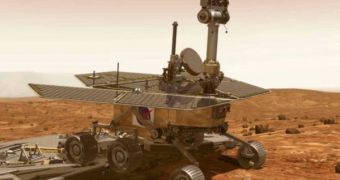According to new data released by NASA and JPL-Caltech, the Spirit exploration rover received a larger input of electricity on February 6th, which seems to indicate the fact that Martian winds managed to blew a significant quantity of the dust that covered the robot's solar panels. This is nothing but good news for the team managing both Mars Exploration Rovers (MER), as this will give them more power to work with Spirit for longer periods of time each day, and will also remove the looming specter of battery depletion from the resilient machine.
“We will be able to use this energy to do significantly more driving. Our drives have been averaging about 50 minutes, and energy has usually been the limiting factor. We may be able to increase that to drives of an hour and a half,” NASA's Jet Propulsion Laboratory rover mission manager Colette Lohr, from Pasadena, California, explains. The energy input increased from an average of 210 watts-hour to approximately 240 watt-hours, which means that Spirit will now have the ability to dedicate more of its electricity to driving and using its instruments than it did before.
On average, 180 watt-hours are used daily just to maintain the rover alive, and to drive it around for a little bit. The more energy reserves grow, the more electricity it will have to spare for actually cruising on the Red Planet, collecting invaluable scientific data from the Martian surface. However, NASA experts draw attention to the fact that, even with the new “cleaning,” only 28 percent of the sunlight hitting the arrays gets converted into energy.
The increase from 25 to 28 percent may not seem like much, “but it is an important increase,” rover team engineer Jennifer Herman, from JPL, points out. Since January 31st, when it experienced some glitches, the machine advanced 9 meters (about 30 feet), after going around a rock that temporarily blocked its path of advancement. It's rover brother, Opportunity, drove 135.9 meters (446 feet) on February 10th alone, bringing the grand total to 14.36 kilometers (8.92 miles) since it first landed on Mars.
The two resilient MER components were originally scheduled just for a three month-long mission on the Red Planet, but they proved to be so strong that the mission is even now ongoing, more than 5 years later.

 14 DAY TRIAL //
14 DAY TRIAL //